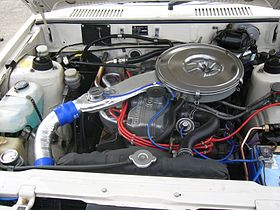
The Chrysler 1.8, 2.0, and 2.4 are inline-4 engines designed originally for the Dodge and Plymouth Neon compact car. These engines were loosely based on their predecessors, the Chrysler 2.2 & 2.5 engine, sharing the same 87.5 mm (3.44 in) bore. The engine was developed by Chrysler with input from the Chrysler-Lamborghini team that developed the Chrysler/Lamborghini Formula 1 V12 engine in the early 1990s.
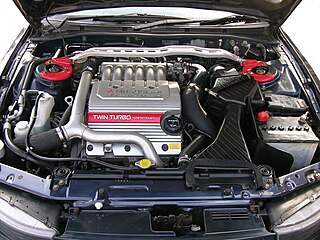
The Mitsubishi 6A1 engine is a series of piston V6 engines from Mitsubishi Motors, found in their small and medium vehicles through the 1990s. They ranged from 1.6 to 2.5 L in size, and came with a variety of induction methods and cylinder head designs and configurations.

The Mitsubishi Sirius or 4G6/4D6 engine is the name of one of Mitsubishi Motors' four series of inline-four automobile engines, along with Astron, Orion, and Saturn.
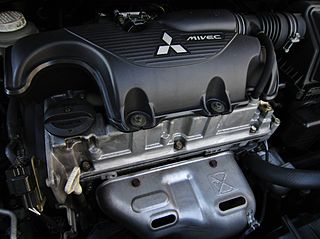
The Mitsubishi Orion or 4G1 engine is a series of inline-four internal combustion engines introduced by Mitsubishi Motors in around 1977, along with the Astron, Sirius, and Saturn. It was first introduced in the Colt and Colt-derived models in 1978. Displacement ranges from 1.2 to 1.6 L.

The Mitsubishi 4G9 engine is a series of straight-4 automobile engines produced by Mitsubishi Motors. All are 16-valve, and use both single- and double- overhead camshaft heads. Some feature MIVEC variable valve timing, and it was the first modern gasoline direct injection engine upon its introduction in August 1996.

The 6G7 series or Cyclone V6 engine is a series of V6 piston engines from Mitsubishi Motors. Five displacement variants were produced from 1986 to 2021, with both SOHC and DOHC, naturally aspirated and turbo charged layouts. While MIVEC variable valve timing has also been implemented in some versions the 2.5, 3.0, and 3.5 L versions were also available with gasoline direct injection. This engine has been the flagship powerplant of the company except when they briefly built a V8 in 1999–2001. The staple of their high-end sedans, it was given twin-turbos for the Mitsubishi GTO, and became the most powerful car ever built by the company at the time.

The E-series was a line of inline four-cylinder automobile engines designed and built by Honda for use in their cars in the 1970s and 1980s. These engines were notable for the use of CVCC technology, introduced in the ED1 engine in the 1975 Civic, which met 1970s emissions standards without using a catalytic converter.

The Honda D series inline-four cylinder engine is used in a variety of compact models, most commonly the Honda Civic, CRX, Logo, Stream, and first-generation Integra. Engine displacement ranges between 1.2 and 1.7 liters. The D Series engine is either SOHC or DOHC, and might include VTEC variable valve lift. Power ranges from 66 PS (49 kW) in the Logo to 130 PS (96 kW) in the Civic Si. D-series production commenced in 1984 and ended in 2005. D-series engine technology culminated with production of the D15B 3-stage VTEC (D15Z7) which was available in markets outside of the United States. Earlier versions of this engine also used a single port fuel injection system Honda called PGM-CARB, signifying the carburetor was computer controlled.

The Suzuki G engine is a series of three- and four-cylinder internal combustion engines manufactured by Suzuki Motor Corporation for various automobiles, primarily based on the GM M platform, as well as many small trucks such as the Suzuki Samurai and Suzuki Vitara and their derivatives.
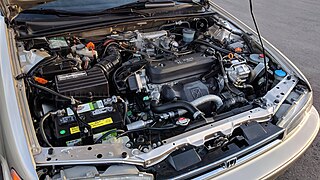
The Honda F-Series engine was considered Honda's "big block" SOHC inline four, though lower production DOHC versions of the F-series were built. It features a solid iron or aluminum open deck cast iron sleeved block and aluminum/magnesium cylinder head.

The Toyota HD is a series of Diesel engines produced by Toyota.

The MA is a straight-4 SOHC 0.9 L, 1.0 L, or 1.2 L engine first introduced in 1982 by Nissan, intended primarily for the K10 series Micra/March model. It shares design similarities with the older E engine, with an 8-valve hemispherical cylinder head but differs in that it uses an aluminium cylinder block. Unusually, the specified ignition timing for the MA10 running on the specified 90 RON gasoline was 2 degrees after top dead centre, reflecting a very high flame speed in the compact combustion chambers.

The Mitsubishi 3G8 engine is a range of three-cylinder powerplant from Mitsubishi Motors, introduced in the fifth generation of their Mitsubishi Minica kei car. In common with other contemporary engines in the class, it could be specified with many advanced technologies despite its diminutive size, including multi-valve cylinder heads and double overhead camshafts. The top-of-the-line Dangan ZZ variant was also the first kei car to benefit from turbocharging. In 1987 Mitsubishi was the first manufacturer to supercharge a kei vehicle, and in 1989 became the world's first production car to feature five valves per cylinder, ahead of similar developments by Bugatti, Audi, Ferrari and Toyota.
The Mitsubishi 4M4 engine is a range of four-cylinder diesel piston engines from Mitsubishi Motors, first introduced in the second generation of their Montero/Pajero/Shogun SUVs. They superseded the previous 4D5 engine family, main differences are enlarged displacements and the utilization of one or two over-head camshafts. Originally available only as a 2835 cc intercooled turbo, detail improvements in 1996 and a larger 3.2 litre option in 1999 served to improve power, torque, fuel economy and emissions. The final version has 3.0 litres swept volume and Common rail direct injection.

The Mitsubishi 4A3 engine is a range of alloy-headed inline four-cylinder engines from Mitsubishi Motors, introduced in 1993 in the sixth generation of their Mitsubishi Minica kei car. It shares a 72 mm (2.8 in) bore pitch with the 3G8-series three-cylinder engines, but has a considerably shorter stroke so as to stay beneath the 660 cc limit imposed by the Kei class.

The EA827 family of petrol engines was initially developed by Audi under Ludwig Kraus leadership and introduced in 1972 by the B1-series Audi 80, and went on to power many Volkswagen Group models, with later derivatives of the engine still in production into the 2010s. This is a very robust water-cooled engine configuration for four- up to eight- cylinders. In Brazil this engine was produced under the name Volkswagen AP AP.

The E0 series is a three-cylinder gasoline engine developed and manufactured by Honda, with a total displacement of 656 cc. The engine is intended for kei car applications. The E05A and E07A were partially replaced by the Honda P engine but as of 2020 the E07Z engine still saw use in the Acty truck.
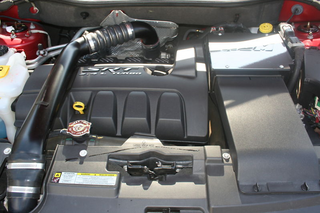
The World Gasoline Engine is a family of straight-4 piston engines, based on the Global Engine Alliance design.
